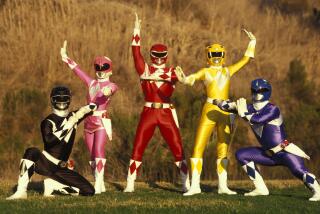Enough of Power Rangers? Japan Readies Super Rival : Marketing: ‘Sailor Moon’ is ready to fight evil and sexism--just as soon as she puts on her makeup.
- Share via
TOKYO — Family budgets that survived the Mighty Morphin’ Power Rangers will soon face an assault from another team of Japanese super-heroes--wearing pleated miniskirts and go-go boots.
“Sailor Moon,” a blond, ponytailed teen-ager, and her girlfriends are on the way to combat evil and sexism--and sell as many dolls, trinkets and toys as possible.
DIC Productions of Burbank plans to bring the Japanese cartoon series into American homes in September. Japan’s Bandai Co., which can’t make Power Ranger toys fast enough to feed U.S. demand, has rights to the merchandising.
The Japanese creators of the Sailor Moon cartoon attribute its immense popularity in Japan to the casting of strong females as central characters. The American version will retain female empowerment as a frequent theme.
“Today’s little girls want to be just as strong as boys,” said DIC spokesman Jeff Pryor. “Barbie is not really an appropriate role model anymore.”
But these so-called warriors-against-sexism characters wear miniskirts and draw their power from makeup--and sometimes get help from Sailor Moon’s love interest, a masked man named Tuxedo who often appears when the girls are in trouble.
The cartoon’s creators don’t see any contradiction in having Tuxedo bail out the young defenders of feminism.
“Tuxedo is part of the Sailor Moon team. It’s all of them fighting evil together,” said Kenichi Ebato of Toei Animation Co. Ltd. “Sometimes she helps him as well when he gets in trouble.”
Some of the racier moments from the Japanese version will hit the cutting-room floor, including when one of Sailor Moon’s team proudly refers to the size of her breasts, said DIC president Andy Heyward.
Known in Japan as “Pretty Soldier Sailor Moon,” the title character in everyday life is a brash and disheveled 14-year-old named Usagi, who like most Japanese junior high school girls wears a sailor-style uniform.
Using magical brooches, scepters and compacts, Usagi and her girl companions transform into fast-thinking, stylish super-heroines who use power rays to fight otherworldly demons.
In one episode, a female alien sends her male underling to lure Sailor Moon and her crew to an airport where he scoffs at their abilities and tries to run them over with airplanes.
The girls shout “Scorn for women is a thing of the past!” and “Don’t belittle women!” while using their powers to make the planes chase him away.
Almost all of the forces of evil in the show are older women, however, not men.
Each member of Sailor Moon’s team is named for a celestial body. The U.S. version will drop “Pretty Soldier” from the title.
Since picking up the rights last month, DIC has signed up enough stations to reach 85% of U.S. homes, Heyward said. The series has already done well in France, Spain and Hong Kong, he said.
In Japan, Sailor Moon handily outsells her super-hero competitors.
Since going on the air in 1992, Sailor Moon has generated $1.58 billion in retail sales in Japan, more here than the Rangers, Teenage Mutant Ninja Turtles and Barbie combined, according to DIC.
It seems every Japanese girl who watches the show has to have her own brooch, scepter and makeup kit, all in bright pink and emblazoned with hearts. Combined, they cost more than $100.
“I like it best when she transforms!” Eriko Hinode, 4, says excitedly at the Toy Park store, showing how she waves her toy scepter and brooch, then spins around like the Sailor characters.
Toy Park, a four-story store in downtown Tokyo, estimates that 65% of its Sailor Moon sales go to little girls and 25% more to little boys, who like the scepters and character figurines.
Young men and women as old as their late 20s buy the remaining 10%, store spokesman Takashi Nakamura says. Their favorite item is a $98 electronic date book.
More to Read
The biggest entertainment stories
Get our big stories about Hollywood, film, television, music, arts, culture and more right in your inbox as soon as they publish.
You may occasionally receive promotional content from the Los Angeles Times.








